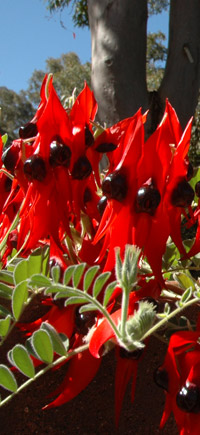Sturt's desert peas
Potted Sturt's Desert Peas were displayed around the Gardens in the spring and summer of 2008 – 2009.
The horticulturists experimented with fertilisers, tip-pruning and other environmental controls to optimise and prolong the flowering. The tip-pruning led to the production of 20 to 30 short stems with many groups of flowers (inflorescences) per stem, each containing up to 8 flowers. This is 10 to 20 times more stems than would normally feature on this plant in the wild.
Due to their susceptibility to fungal and root diseases in Canberra's cooler and wetter environment, the Sturt's Desert Peas were grafted onto a rot-resistant New Zealand plant, Clianthus puniceus.
After the first year, around a third of the plants remain alive.
Plant deaths were attributed to the loss of stems through wind damage outdoors, or from dry conditions indoors. The remaining plants could live to five years if improvements can be made to protect them from the wind. Plans are underway for additional supports, wind breaking structures, and training of stems.
A chemical plant growth regulator that could partially replicate the results from the tip-pruning exercise may be trialled. The chemical promotes shoot growth and reduces the length of stems.
A small trial of seed grown plants is planned. An accompanying fact-sheet with the results of the trial will help inform the home gardener.
![Director of National Parks [logo]](../../../images/dnp_90px.gif)






